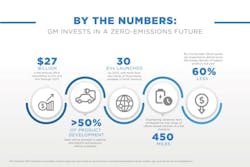In the November issue of MTD, I wrote that “electric vehicles are here to stay.” This statement has been underscored by two recent announcements - one by the White House and another by one of the world’s largest automobile manufacturers.
An executive order signed by President Joe Biden in late-January calls for - among other things - the replacement of internal combustion engine-powered government fleet vehicles with “clean, electric vehicles.” That’s more than 645,000 vehicles that will make the switchover. How and when will this happen? Those details haven’t been shared publicly. (According to reports, as of 2019, fewer than 4,500 government-owned vehicles were electric.) But the fact that this was part of a major, highly publicized executive order is significant.
Just days later, General Motors (GM) announced that it’s investing a whopping $27 billion in electric and autonomous vehicles over the next five years. The goal is to offer 30 electric-powered vehicles on a worldwide scale within the next four years, with 40% of all GM models sold in the U.S. going all-electric by the end of 2025.
In a public statement, GM officials said that the company’s investment “includes the continued development of GM’s Ultium battery technology,” retooling facilities in Michigan and Tennessee to build electric vehicles and other actions.
The automaker has already launched a big marketing push to help educate consumers. (Did you catch this commercial that appeared during last night’s Super Bowl? "GM’s Ultium battery is made for all types of vehicles,” says the spot’s hyper-enthusiastic-yet-somewhat-befuddled main character, played by actor Will Ferrell, “so soon, everyone can drive an EV.”)
Electric cars, as a concept, are not new. The first crude electric vehicle was developed in 1832. The first successful electric car in the U.S. debuted in 1890. By 1900, electric cars accounted for nearly one-third of all cars in the U.S., according to the U.S. Department of Energy, whose online history of electric vehicles, published here, provides more information about the ebbs and flows of market demand for electric-powered vehicles over the last 100 years.
While I still maintain that the widespread adoption of electric cars by the general motoring public will not happen as quickly as some believe, there is no doubt that we, as an industry, have entered a new age of “electrification.” More than 325,000 electric cars were sold in the U.S. during 2019 - the second highest number on record and 23% of all plug-in electric cars that have been sold in the U.S. since 2010.
Full-year 2020 electric car sales numbers are not yet available, but I’m sure even more were sold during that period. And there's no doubt this sales trend will continue into 2021 and beyond. (We haven't even started to talk about electric commercial trucks in this forum.)
MTD will continue to track all of the above, including what it means for you, the independent tire dealer who will service and provide tires for electric vehicles.





